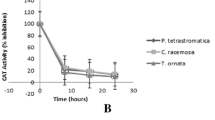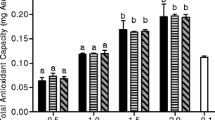Abstract
As a part of an ongoing search for antioxidants frodm marine sources, antioxidant activities of 24 kinds of seaweeds (4 green algae, 8 brown algae, and 12 red algae) were investigated. The seaweeds were extracted by acetone/ dichloromethane and methanol, respectively. The antioxidant properties of both extracts were evaluated using four different activity tests, including degree of occurrence of intracellular reactive oxygen species (ROS), NO, lipid peroxidation, and GSH (glutathione) in mouse macrophage Raw 264.7 cells. The levels of intracellular reactive oxygen species (ROS) and GSH were measured using 2’,7’-dichlorofluorescin diacetate (DCF-DA) and monobromobimane as fluorescence probe, respectively. Moreover, the generation of NO and lipid peroxidation products were determined by each method based on the Griess reaction and TBARS assay. Solvent extracts from seaweeds such asScytosiphon lomentaria, Prionitis cornea, Laruencia okamurae,Callophyllis japonica, Sargassum horneri, Dictyopteris divaricat a,Lomentaria catenata, Corallina confuse, Ishige okamurae, andAhnfeltiopsis flabelliformi exhibited high antioxidant activities in cellular oxidizing systems.
Similar content being viewed by others
References
Ali, M.S., M. Jahangir, M. Saleem, M.K. Pervez, S. Hameed, and V.U. Ahmad. 2000. Metabolites of marine algae collected from Karachi-coasts of Arabian sea.Nat. Prod. Sci.,6(2), 61–65.
Arató, E., M. Kürthy, G. Jancsó, L. Sínay, G. Kasza, Z. Verzár, L. Benko, B. Cserepes, L. Kollár, and E. Roth. 2006. Oxidative stress and leukocyte activation after lower limb revascularization surgery.Magy. Seb.,59(1), 50–7.
Blomgren, K. and H. Hagberg. 2006. Free radicals, mitochondria, and hypoxia—ischemia in the developing brain.Free Radic. Biol. Med.,40, 388–397.
Chen, Y., K. Hsu, J. Tsai, C. Hung, T. Kuo, and Y. Chen. 2005. Involvement of protein kinase C in the inhibition of lipopolysaccharide-induced nitric oxide production by thapsigargin in RAW 264.7 macrophages.IJBCB,37, 2574- 2585.
Gomes, A., E. Fernandes, and J. Lima. 2005. Fluorescence probes used for detection of reactive oxygen species.J. Biochem. Biophys. Meth.,65, 45–80.
Green, L.C., D.A. Wagner, G.J. logowski, P.L. Skipper, J.S. Wishnok, and S.R. Tannenbaum. 1982. Analysis of nitrate, nitrite, and [15N] nitrate in biological fluids.Analyt. Biochem.,126, 131–138.
Hansen, M.B., S.E. Nielsen, and K. Berg. 1989. Re-examination and further development of a precise and rapid dye method for measuring cell growth/ cell kill.J. Immunol. Meth.,119, 203–210.
Heath, R.L. and L. Packer. 1968. Photoperoxidation in isolated chloroplasts. I Kinetics and stoichiometry of fatty acid peroxidation.Arch. Biochem. Biophys.,125, 189–198.
Je, J. and S. Kim. 2006. Reactive oxygen species scavenging activity of aminoderivatized chitosan with different degree of deacetylation.Bioorgan. Med. Chem.,14, 5989–5994.
Jung, H.A., H.J. Lee, Y.A. Kim, K.E. Park, J.W. Ahn, B.J. Lee, S.G. Moon, and Y. Seo. 2004. Antioxidant activity of Artemisia capillaries Thunberg.Food Sci. Biotechnol.,13, 328–331.
Komaki-Yasuda, K., S. Kawazu, and S. Kano. 2003. Disruption of the Plasmodium falciparum 2-Cys peroxiredoxin generenders parasites hypersensitive to reactive oxygen and nitrogen species.FEBS Lett.,547, 140–144.
Lee, H.J., Y.A. Kim, J.W. Ahn, B.J. Lee, S.G. Moon, and Y. Seo. 2004a. Screening of peroxynitrite and DPPH radical scavenging activities from salt marsh plants. Korean J. Biotechnol.Bioeng.,19, 57–61.
Lee, H.J., K.E. Park, J.S. Yoo, J.W. Ahn, B.J. Lee, and Y. Seo. 2004b. Studies on screening of seaweed extracts for peroxynitrite and DPPH radical scavenging activities.Ocean and Polar Res.,26, 59–64.
Lee, H.J. and Y. Seo. 2006. Antioxidant properties of Erigeron annuus extract and its three phenolic constituents.Biotechnol. Bioproc. Eng.,11(1), 13–18.
Lee, H.J., Y.A. Kim, J.W. Ahn, H.-J. Na, H.-M. Kim, and Y. Seo. 2006. Screening of Korean marine plants for their inhibitory effect on histamine release from RPMC in vitro.Biotechnol. Bioproc. Eng.,11(1), 80–83.
Okimoto, Y., A. Watanabe, E. Niki, T. Yamashita, and N. Noguchi. 2000. A novel fluorescent probe diphenyl-1-pyrenylphosphine to follow lipid peroxidation in cell membranes.FEBS Lett.,474, 137–140.
Patel, R.P., J. McAndrew, S H. ellak, C. Roger White, H. Jo, B.A. Freeman, and V.M. Darley-Usmar. 1999. Biological aspects of reactive nitrogen species.Biochim. Biophys. Acta,1411, 385–400.
Poot, M., A. Verkerk, J.F. Koster, and J.F. Jongkind. 1986. De novo synthesis of glutathione in human fibroblasts during in vitro ageing and in some metabolic diseases as measured by a flow cytometric method.Biochim. Biophys. Acta,883, 580–584.
Reiter, R.J., D.X. Tan, and S. Burkhardt. 2002. Reactive oxygen and nitrogen species and cellular and organismal decline: Amelioration with melatonin.Mech. Ageing Dev.,123, 1007–1019.
Seo, Y., H.J. Lee, K.E. Park, Y.A. Kim, J.W. Ahn, J.S. Yoo, and B.J. Lee. 2004. Peroxynitrite scavenging constituents from the brown AlgaSargassum thunbergii.Biotechnol. Bioproc. Eng.,9, 212–216.
Sies, H. 1999. Glutathione and its role in cellular function.Free Radic. Biol. Med.,27, 916–921.
Tsao, L., P. Tsai, R. Lin, L. Huang, S. Kuo, and J. Wang. 2005. Inhibition of lipopolysaccharide-induced expression of inducible nitric oxide synthase by phenolic (3E)-4-(2-hydroxyphenyl)but- 3-en-2-one in RAW 264.7 macrophages.Biochem. Pharmacol.,70, 618–626.
Virag, L., E. Szabo, P. Gergely, and C. Szabo. 2003. Peroxynitrite - induced cytotoxicity: Mechanism and opportunities for intervention.Toxicol. Lett.,140-141, 113–124.
Watson, W. H. and D.P. Jones. 2003. Oxidation of nuclear thioredoxin during oxidative stress.FEBS Lett.,543, 144- 147.
Yamaji, K., Y. Wang, Y. Liu, K. Abeyama, T. Hashiguchi, T. Uchimura, K.K. Biswas, H. Iwamoto, and I. Maruyam. 2005. Activated protein C, a natural anticoagulant protein, has antioxidant properties and inhibits lipid peroxidation and advanced glycation end products formation.Thrombosis Res.,115, 319–325.
Author information
Authors and Affiliations
Corresponding author
Rights and permissions
About this article
Cite this article
Kim, Y.A., Kong, C.S., Um, Y.R. et al. Antioxidant efficacy of extracts from a variety of seaweeds in a cellular system. Ocean Sci. J. 43, 31–37 (2008). https://doi.org/10.1007/BF03022429
Received:
Revised:
Accepted:
Issue Date:
DOI: https://doi.org/10.1007/BF03022429




